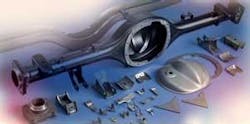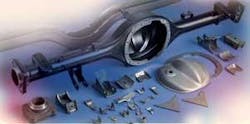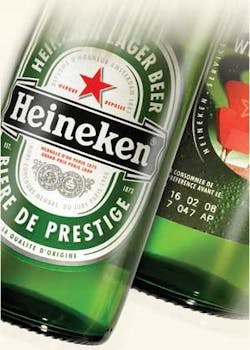Light prototypes to keep on trucking
Rochester Hills, MI-Many automakers have begun programs to find the right combination of engine, drivetrain, power train, and driveline components to deliver optimum driving performance and mileage ratings. For one automaker this combination includes a new high-strength, lightweight “banjo” rear-axle concept for two- and four-wheel-drive truck models. A banjo axle is typically constructed from stamped, high-strength components welded together to form a lighter-weight axle housing.
To avoid interruptions to existing production cycles, the company’s power-train engineers went to 3-Dimensional Services Group, a rapid-prototyping firm whose advanced process methods and manufacturing technologies produce prototype parts 70% faster than conventional shops. The housing to be worked on consisted of nearly 30 individual stampings and many structural components-some fabricated from 4.5-mm-thick, high-strength sheet steel and others from 1008-1010 carbon steel. With the vehicle company’s engineers looking for as many as 55 axle housing units within a 10-week delivery time frame, work started fast at 3-Dimensional-with only the part design provided.
The engineers began work on the dies for producing the various stampings, including the two axle halves-the upper and lower U-formed housing pieces, which measure nearly 5 1/2 feet in length with a nearly 7-in.-deep radius draw for the differential section. Attention to the weld fixtures and tools required to secure and accurately locate the 28 or so different pieces followed. The tools needed to be precise, yet highly adaptive to prevent any distortion that could occur during the welding stages.
Because of the number of parts, quality checks, and processes involved in completing the axles, there was a possibility for multiple delays. In addition to the axle halves, other stamped pieces included baffles, front and rear backing plates, rear cover, front mounting ring, strengthening gussets, numerous brake cable guides and hose brackets, harness brackets, spring seats and reinforcements, shock brackets, drain plug insert, and pipe brackets.
The large upper and lower halves of the axle were formed in 3-Dimensional Services’ 160-ton press. The stamping operations were sped along by the use of both Kirksite and aluminum alloys for die materials. After the stampings were completed, the upper and lower housing halves were laser trimmed using some of the company’s 13 five-axis laser-processing systems. The laser trimming provided the accurate height of each half’s axle wall that, when assembled, results in the correct ID for the axle shafts and differential gearing and carrier.
With the forming and laser trimming completed, the main section halves were welded together and then machined. The next process was to assemble the hub forgings and weld them in place, then weld the miscellaneous brackets to the housing.
A critical step in the welding was to verify production intent by completing the wheel flange welding process in a single, continuous weld using two robotic arms in unison-one generating the weld and one controlling the rotation of the part. All welding parameters-heat, cycle, and so forth-were recorded to provide the auto company with data for production runs. Following welding certification inspection, each assembly and weld were leak tested and quality-control inspected, sent for E-coat, and finally machined and CMM inspected.
The first pieces were shipped to the vehicle’s prototype assembly and test center in the 10-week time period, and 3-Dimensional is now completing a second run of modified parts. These prototypes included full verification of their manufacturing intent and process standards, so that, if this axle design is selected for future truck models, the automaker and its future high-volume suppliers will have a head start in implementing a manufacturing process and a successful, timely production launch. What’s more, the automaker now has the production-like quality and integrity with which to gauge the functioning of these axles and to determine their effect on overall vehicle performance.
For more detail, visit the 3-Dimensional Services Web site: www.3dimensional.com.
Better beer bottle labeling
Schiltigheim, France-To improve marking speed and print quality, the Heineken Brewery here chose a scribing laser coder from Linx Printing Technologies (Cambridgeshire, UK; www.linxglobal.com) to provide effective coding onto the labels on its glass bottles. The company chose the Linx 500SL scribing laser because of its high speed, excellent print quality, and low cost of ownership compared to mask lasers (technology Heineken used previously), which require the use of CO2 gas cartridges for operation.
Integration with the existing labeling machine in use at the plant was a key concern for Heineken in order to save valuable floor space and to allow improved access to the labeling machine for operation and maintenance.
Linx devised a set up where the laser is mounted horizontally above the labeling machine, with the arm and marking head reaching down to the pallet station where the bottles are coded. A shaft encoder is installed to prevent speed variation and to deliver a sync print signal.
“The experience of Linx’s engineers in dealing with labeling machinery enabled them to install the complete coding solution without the need to employ a third party as systems integrator, thus optimizing the efficiency of the project,” comments Sophie Lesenfans, industrial buyer at Heineken.
The new system prints a two-line code onto the paper labels, incorporating the Use By date on the top line and traceability information-the date of manufacture, the production line number, and the shift code-on the second (see photo). Speeds of up to 50,000 labels/hour have been achieved. Total traceability is assured by a computer link with the production management system, which enables automatic updating of codes and dates without manual intervention.


